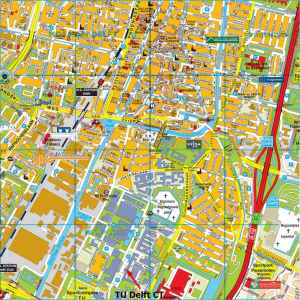What are we doing?
Design two versions of a pedestrian map of the centre of Delft in such a way, that it influences the behaviour of the users.
On the square in front of the central railway station, a large map will be placed by the city of Delft. It offers visitors a wide scope of rich information, about museums, theatres, interesting buildings, picturesque streets and courts, shops, shopping areas, restaurants, and other places and scenes of interest.
On the map the recommended walking route is clearly presented. This route starts and ends at Delft central station. The course it follows is:
Delft central station, Westvest, Phoenixstraat, St. Agathaplein, H. Geest Kerkhof, Choorstraat, Vrouw Jutteland, Vrouwenrecht, Oude Langendijk, Burgwal, Beestenmarkt, Kruisstraat, Pijnepoort, Bastiaansplein, Vesteplein, Breestraat, Barbarasteeg, Delft central station.
Visitors may follow this course in either direction. Clockwise, the ‘Museum route’, or anticlockwise, the ‘shopping route’.
Shopkeepers in Delft fear that if the route is followed clockwise, the ‘Museum route’, visitors will have no time left for shopping at the end of the day. On the other hand, the town council doesn’t want visitors to spend most of their time shopping without an eye for the cultural treasures the city has to offer.
Design
After some deliberation it has been agreed by the town and the shopkeepers that there will be two versions of the map alternating every day.
The two versions of the map will be presented on a large LCD-screen of 6 x 8 meter. Visitors cannot influence which version is shown. For them it is a static map with no interactive possibilities.
The differences in the two versions should be subtle. In fact, a visitor who comes the next day may not even be aware that the map differs from the one of the previous day. You will have to make a very refined and clever use of the possibilities the theory of visual perception offers. In Colin Ware’s book ‘Visual Thinking for Design’ (chapters 1, 2, 3 and 4) you will find the information you need. The effect of the versions has to be that on the one day significantly more visitors will follow the ‘Museum route’ than the ‘shopping route’, and on the other day this should be the other way around. To achieve this effect is your design task.



Leave a comment